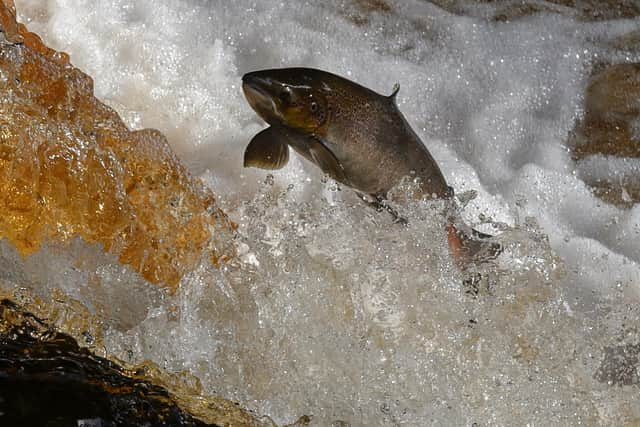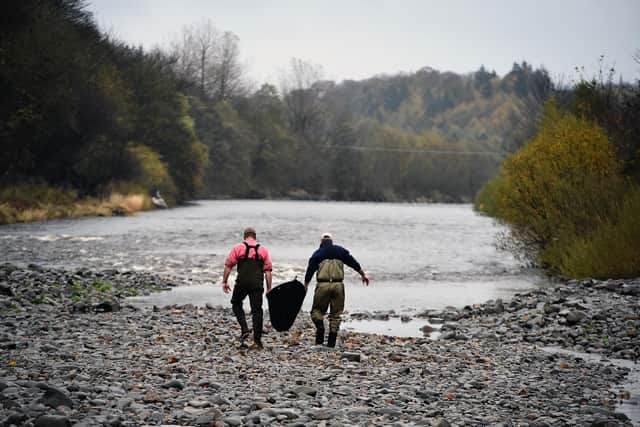Atlantic salmon have been in decline for two generations - but what role does climate change play in their demise?
Primarly, there is the ban on netting at river mouths where exhausted fish return home to spawn in the burns where they first hatched or head into the oceans for the first time.
In conjunction with a crackdown on netting – which was a dying trade already due to low catches – voluntary, and some not-so-voluntary, catch and return schemes were introduced to at least preserve numbers and increase how many fish made it upriver to spawn.
Advertisement
Hide AdAdvertisement
Hide AdAnd then there’s science, with aquaculture experts trapping young salmon – known as smolts – to monitor their numbers. Some are now having tiny trackers inserted internally so their movements can be traced.


The smolts travel downstream to the sea where they will live and grow for up to four years until they are ready to return as adults to spawn.
At sea, salmon travel with the ocean currents and eat plankton, small fish and fish fry – and their main sources of food could be largely where the problem lies, along with over-fishing.
Due to climate change, global warming has already seen sea temperatures rise with dire effects on very creatures the young salmon rely on to thrive and grow to adulthood.
Now, fears have been raised for the future of the Atlantic salmon, sea trout and brown trout on the once bountiful River Tweed as climate change is blamed for the drought affecting several parts of Scotland.


The River Tweed Commission (RTC) has warned current water scarcity plans are not robust enough o protect its fish stocks and has voiced concerns at the "significant problems" being created by low water levels and high temperatures t.
The group wants a review of the system still allowing water extraction from the 97 mile long river by industry and agriculture.
The Scottish government has said it worked closely with experts to decide what actions to take to tackle scarcity in the Scottish Borders and Fife in particular.
Advertisement
Hide AdAdvertisement
Hide AdThe Scottish Environment Protection Agency (Sepa) has issued a number of warnings about low water levels with the east of the country more badly affected than the west.
Clerk to the RTC, Jamie Stewart, said the prolonged dry period was causing concerns along the river, its tributaries and beyond.
He added: "Migration between river pools in the catchment becomes much more difficult, with access to shade and protection from predators often denied as a result.
"In addition, low river levels cause changes to the nutrient concentration levels in the water, which are leading to greater areas of algal bloom on the riverbed.
"Warm water holds less dissolved oxygen than cold water, so summer is the time when fish can have a hard time getting enough oxygen."
Mr Stewart questioned the suitability of the system currently in place with the river's "moderate" scarcity classification meaning water abstraction for agriculture and industry were still allowed.
However, he said the past two years had seen the Borders record Scotland's hottest day on record along with higher average temperatures and low river flows due to climate change.
He also said he did not believe the current system was adequate to support the river environment.
Advertisement
Hide AdAdvertisement
Hide AdThe Scottish government said it had been working with Sepa in dealing with water scarcity issues across the country.
A spokesman added: "We will continue to closely monitor the situation, evaluate the potential environmental, economic and social impacts and consider advice from Sepa and scientific bodies before determining what actions to take.
"The Scottish government takes the issue of our declining salmon stocks very seriously and we are working with stakeholders to safeguard this iconic species."
It said its wild salmon strategy - launched at the start of the year - also set out objectives to ensure the protection and recovery of populations.
Sepa's head of water and planning, Nathan Critchlow-Watton, said its plans had been developed to protect the environment following public consultation.
He said the Tweed was likely to reach significant scarcity in the coming days at which point it could suspend abstraction licences for businesses.
Comments
Want to join the conversation? Please or to comment on this article.